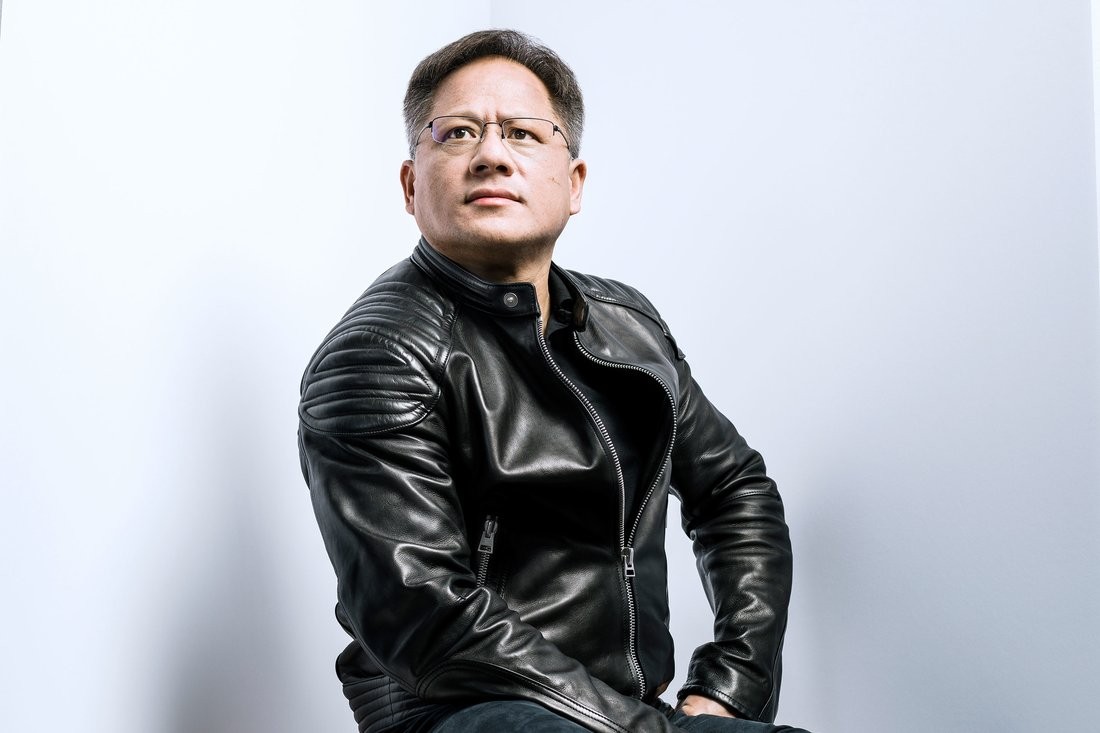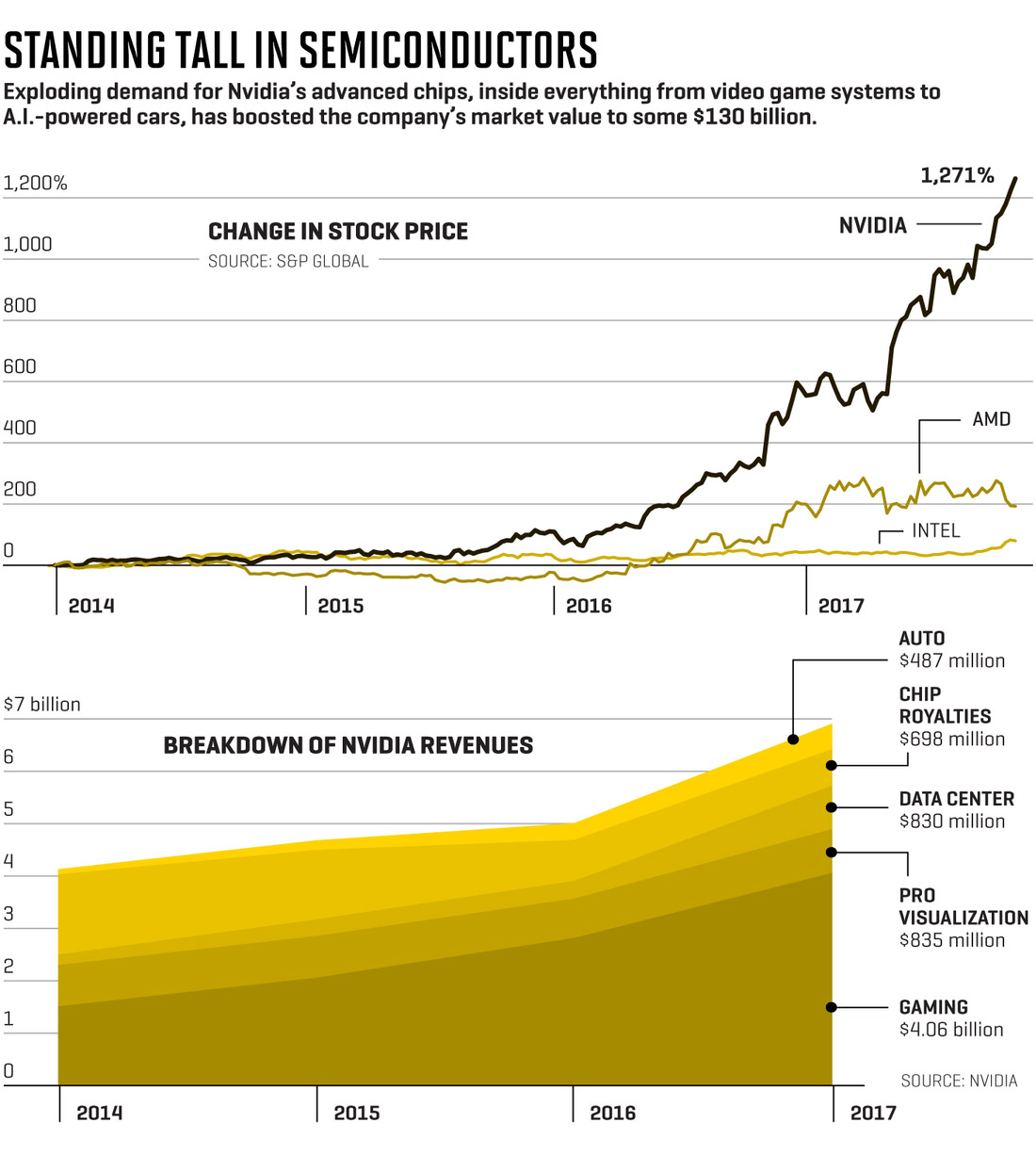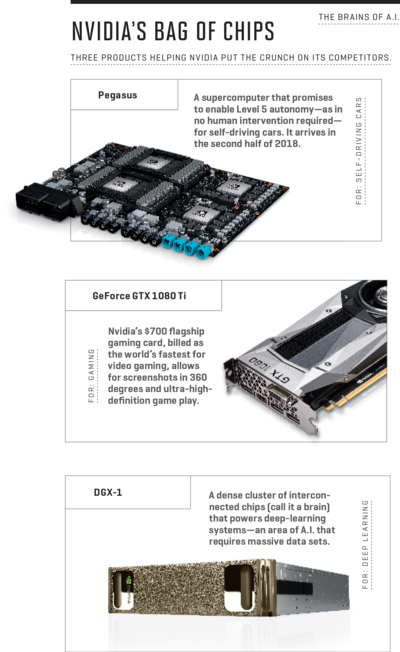《财富》2017年度商人:硅谷人工智能革命的引领者
|
在前往Evvia【这家位于帕洛阿尔托市中心的希腊餐厅热闹非凡,苹果(Apple)的联合创始人史蒂夫·乔布斯生前曾经常光顾这里】就餐的路上,黄仁勋卷起了衬衫的袖子,向我展示他的刺青。刺青有着部落的特色,粗粗的线条延伸穿过他的护肩。在餐厅昏暗温暖的灯光下,黑色的颜料闪烁着光芒。 他眼里闪着亮光,比着手臂的长度说:“我真的想把它延伸到这么长。我确实有点想做,我愿意去做。但那真的非常痛。我哭得像个小孩一样。我的孩子就在我旁边,他们表现得就像是:‘爸,你要控制住自己。’” 黄仁勋的两个孩子业已成年。斯宾塞经营着地下酒吧,麦迪逊是酒店从业者,他们身上也都有刺青。但是他们54岁的父亲,炙手可热的硅谷半导体和软件公司英伟达的联合创始人和首席执行官,目前只有这一个刺青,是公司商标的抽象形状,这是他在大约十年前纹上的。 黄仁勋向后靠在椅子上,讲起了刺青的故事:“每六个月,我们都会离开公司出去玩。某次就有人说:‘如果公司的股价涨到100美元,去做点什么呢?’当时就有不同的意见。有人说他们要剃个光头,或把头发染成蓝色,或弄个莫西干发型。等到他们问到我的时候,已经上升到了刺青的级别。于是我说:‘没问题,到时候我会纹个刺青。’后来,股价涨到了100美元。”他停了一下,做了个苦相,回忆道:“纹身太疼了。” |
Halfway through dinner at Evvia, a bustling Greek restaurant in downtown Palo Alto that Apple cofounder Steve Jobs used to frequent, Jen-Hsun “Jensen” Huang rolls up his shirtsleeve to show me his tattoo. It’s tribal in style, with thick curves extending across his shoulder cap. The black ink gleams in the warm glow of the restaurant’s low lights. “So, I really want to extend it,” he says with a glint in his eye, gesturing along the length of his arm. “I actually kinda do. I would love to. But getting it really, really hurt. I was crying like a baby. My kids were with me, and they’re like, ‘Dad, you’ve gotta control yourself.’ ” Huang’s two adult children, speakeasy proprietor ¬Spencer and hospitality professional Madison, also have tattoos. But at 54, their father, cofounder and CEO of the red-hot Silicon Valley semiconductor and software company Nvidia (NVDA, +1.20%), so far has only this one, an abstract version of the company’s logo. He got it about a decade ago. “Every six months we have an off-site,” Huang says, leaning back in his chair to tell the story. “And at one, someone said, ‘What are we gonna do when the stock price hits $100?’ That was two splits ago. One person said they’d shave their head, or paint their hair blue, or get a mohawk, or something. And another said they’d get a nipple ring. And then by the time they come around to me, it was already at tattoo level. So I said, ‘Yeah all right, I’ll get a tattoo.’ And then the stock price hit $100.” He pauses and grimaces a little, remembering. “And it hurt so bad.” |

|
《财富》美国500强里年过五十的首席执行官,大多都没有刺青,更别说刺青还是自身经营的公司的商标的情况。但出生于台湾的黄仁勋不属于大多数。首先,他在共同创立公司24年后依旧留守经营,这点就很罕见。黄仁勋不仅是一名训练有素的电气工程师【就读于俄勒冈州立大学(Oregon State)和斯坦福大学(Stanford)】,还是一位用鼓励、探寻和往往狂风骤雨般的假期邮件(是在他的假期,而不是员工的假期期间发的)领导员工的强大高管。按照业内许多人的说法,他眼力十足,很早就预见了一种新的计算方式将会带来蓬勃发展的市场,从而提前多年重新定位了他的公司。 这种眼力,以及公司惊人的财务业绩,让黄仁勋当仁不让地成为了《财富》2017年年度商人。 阿多比公司(Adobe)的首席执行官山塔努·纳拉扬表示:“黄仁勋是结合了惊人预见力和不懈执行力的罕见人物。随着英伟达将重心放在了人工智能领域,领导层有了无限机遇可供把握。” 位于旧金山、英伟达三次投资的数据库公司MapD的首席执行官托德·莫斯塔克表示:“我认为黄仁勋是杰夫·贝佐斯和伊隆·马斯克那个档次的人物。” |
Most Fortune 500 CEOs over 50 don’t have tattoos, let alone of the logos of the companies they run. But Huang, who was born in Taiwan, isn’t most Fortune 500 CEOs. For starters, he’s the rare cofounder still running his company 24 years later. He is both a trained electrical engineer (Oregon State; Stanford), and a formidable executive who leads employees with encouragement, inquiry, and often flurries of vacation emails. (Sent during his, not theirs.) And he is, according to many people in the industry, a visionary who foresaw a blossoming market for a new kind of computing early enough to reposition his company years in advance. That vision and his company’s incredible financial performance make Huang the clear choice as Fortune’s Businessperson of the Year for 2017. “Jensen is one of those rare individuals who combines incredible vision with ruthless focus on execution,” says Adobe CEO Shantanu Narayen. “Now with Nvidia’s focus on artificial intelligence, the opportunities for leadership are endless.” “Jeff Bezos, Elon Musk—I put Jensen in that group,” says Todd Mostak, CEO of MapD, a San Francisco database company in which Nvidia has thrice invested. |

|
如果你没听过英伟达,那也情有可原。英伟达不开发聊天应用,也没有搜索服务或任何吸引普通智能手机用户的技术。然而,公司制造了为所有这些应用提供支持的强大的神秘组件。他们的图形处理器(GPU)可以完成复杂的运算,这是加密货币市场、所谓的深度神经网络,以及大屏幕上呈现你看到的绚丽烟花所必需的。同样这些技术,可以让残酷的现实主义射击游戏无比逼真,可以让自动驾驶汽车在没有协助的情况下做出S型拐弯——它们可以赋予计算机视力、听力、理解能力和学习能力。 对英伟达产品的巨大需求,推动了公司的发展。过去三个财年里,英伟达的销售额年均增长19%,利润的年增长则达到了惊人的56%。11月初,公司的财报又一次远超华尔街的预计,每股收益比预期值高出了24%。过去四个季度里,英伟达的总销售额达到90亿美元,利润则达到26亿美元。 这样的业绩让黄仁勋的公司成为了投资者的宠儿。英伟达的股价两年前还在30美元徘徊,近来已经突破了200美元大关。公司的市值如今约为1,300亿美元,正在接近IBM和麦当劳(McDonald’s)。 |
If you haven’t heard of Nvidia, you can be forgiven. It doesn’t make a chat app or a search service or another kind of technology meant to appeal to the average smartphone-toting consumer. No, Nvidia makes the muscular mystery stuff that powers all of it. Its GPUs, or “graphics processing units,” crunch the complex calculations necessary for cryptocurrency markets, so-called deep neural networks, and the visual fireworks you see on the big screen. The same technology that makes brutally realistic shooter games come alive helps self-driving cars take an “S” curve without assistance—enabling computers to see, hear, understand, and learn. Booming demand for its products has supercharged growth at Nvidia. Over the past three full fiscal years, it has increased sales by an average of 19% and profits by an astonishing 56% annually. In early November the company reported results that once again blew past Wall Street’s estimates, with earnings per share 24% higher than expected. In its past four quarters, it has generated total sales of $9 billion and profits of $2.6 billion. Such results have made Huang’s company a darling of investors. Nvidia’s share price, just two years ago hovering around $30, was recently over $200. Its market capitalization, at about $130 billion, is approaching that of IBM (IBM, +1.37%) and McDonald’s (MCD, +0.32%). |

|
与此同时,尽管包括英特尔(Intel)和AMD在内的强大竞争对手希望借助新技术革命的势头增加芯片销售额的份额,但迄今为止,英伟达在图形处理器市场依旧维持了大约70%的市场占有率。Jefferies的股票分析师马克·里帕西斯在7月给客户的照会中写道:“凭借大型计算机,IBM统治了20世纪50年代;向微型电脑的转型,让数字设备公司(Digital Equipment Corp.)在20世纪60年代中期接过权杖;随着个人电脑的风靡,微软(Microsoft)和英特尔各领风骚;最后到手机开始普及的时代,苹果和谷歌独占鳌头。我们相信,下次结构性转变已经开始,而英伟达将从中受益。” 或者就如美国全国广播公司财经频道(CNBC)Mad Money栏目的主持人吉姆·克莱姆腔调十足的说法:“英伟达是我们这个时代最伟大的公司之一。” 黄仁勋与朋友克里斯·马拉科夫斯基和柯蒂斯·普里姆在1993年创立英伟达时,他的脑海里还远远没有与全球最大的科技公司争夺人工智能领域主导权的想法。当时,克里斯·马拉科夫斯基和柯蒂斯·普里姆都是太阳微系统公司(Sun Microsystems)的工程师,而黄仁勋是圣何塞的芯片厂商LSI Logic的主管。马拉科夫斯基和普里姆在公司内部关于未来技术发展方向的政治斗争中失败,迫不及待想要离职。而年仅29岁的黄仁勋基础更为坚实。三人在黄仁勋附近的Denny’s餐厅会面,讨论下一代计算浪潮的正确方向:是更高速的计算,还是基于图形的计算。这顿饭吃完后,黄仁勋下定了决心,离开了LSI公司。 黄仁勋表示:“我们相信这种计算模式可以解决一般用途的计算从根本上无法解决的问题。我们也观察到,电子游戏在计算方面来说,是最具挑战性的难题之一,但它们同时也会在未来带来惊人的销售额。这两个条件并不太经常出现。电子游戏是我们的杀手级应用,它可以充当飞轮,让我们接触到大型市场,获得巨额研发资金,从而解决大量计算问题。” 凭借着银行里的4万美元,英伟达诞生了。公司最早没有名字。黄仁勋说:“我们想不出名字,就给所有的文档命名为NV,意思是‘下一代’(next version)。”由于需要让公司具象化,创始人只能去查阅所有带了这两个字母的单词,他们发现了“invidia”,它在拉丁语中意为“羡慕”。于是名字就这么敲定了。 英伟达成立初期,员工搬进了位于加利福尼亚州森尼维耳市的一间办公室,就在劳伦斯高速公路(Lawrence Expressway)旁边。公司的第一位销售员、如今的执行副总裁杰夫·费舍尔回忆道:“那是一间小办公室。我们会围着一张乒乓球桌吃午饭,并和另一家公司共享浴室。和我们共享停车位的富国银行(Wells Fargo)被抢劫过两三次。” 英伟达的第一款产品是供个人电脑使用的多媒体卡,名为NV1。在它上市的1995年,三维游戏开始逐渐受到人们的欢迎。这张卡卖得不太好,但是英伟达在接下来四次发布中持续改善技术,每次的销量都有所增加,积累了与竞争对手3dfx、ATi和S3对抗的实力。 费舍尔说:“我们知道,想要作为一家公司扩张,我们必须提供更多价值,而不只是个人电脑中一个可以替换的组件。我们需要增加更多价值,不只是一款商品。” |
Nvidia meanwhile has so far managed to retain its roughly 70% market share in GPUs despite competition from formidable rivals—among them Intel (INTC, +0.64%) and AMD (AMD, +1.26%)—who want their share of the billions in chip sales to come from this new tech revolution. “IBM dominated in the 1950s with the mainframe computer, Digital Equipment Corp. in the mid-1960s with the transition to mini-computers, Microsoftand Intel as PCs ramped, and finally Apple and Google as cellphones became ubiquitous,” wrote Jefferies equity analyst Mark Lipacis in a July note to clients. “We believe the next tectonic shift is happening now and Nvidia stands to benefit.” Or as Jim Cramer, host of CNBC’s Mad Money, put it on air in November: “Nvidia is one of the great companies of our time.” Battling with the world’s biggest tech companies for A.I. supremacy was far from Jensen Huang’s mind when he cofounded Nvidia with friends Chris Malachowsky and Curtis Priem in 1993. At the time, Malachowsky and Priem were engineers at Sun Microsystems, and Huang was a director at San Jose chipmaker LSI Logic. Malachowsky and Priem had lost a political battle within Sun over the direction of its technological development and were itching to leave. Huang, just 29 years old, was on firmer ground. The three men met at a Denny’s restaurant near Huang’s home to discuss what they believed was the proper direction for the next wave of computing: accelerated, or graphics-based, computing. Huang walked away from the meal with enough conviction to leave his position at LSI. “We believed this model of computing could solve problems that general-purpose computing fundamentally couldn’t,” Huang says. “We also observed that video games were simultaneously one of the most computationally challenging problems and would have incredibly high sales volume. Those two conditions don’t happen very often. Video games was our killer app—a flywheel to reach large markets funding huge R&D to solve massive computational problems.” With $40,000 in the bank, Nvidia was born. The company initially had no name. “We couldn’t think of one, so we named all of our files NV, as in ‘next version,’ ” Huang says. A need to incorporate the company prompted the cofounders to review all words with those two letters, leading them to “invidia,” the Latin word for “envy.” It stuck. Nvidia’s early employees moved into an office in Sunnyvale, Calif., by the Lawrence Expressway. “It was a small office. We had lunch around a Ping-Pong table. We shared a bathroom with another company,” recalls Jeff Fisher, the company’s first salesman and currently an executive vice president. “The Wells Fargo bank that shared our parking lot got robbed two or three times.” Nvidia’s first product, a multimedia card for personal computers called NV1, arrived in 1995 at a time when three-dimensional games began to gain traction. The card didn’t sell well, but the company kept tinkering with its technology over four more releases, gaining sales—and traction vs. rivals 3dfx, ATi, and S3—each time. “We knew that in order for us to scale as a company, we had to provide more value than just a replaceable component in a PC,” says Fisher. “We had so much more value to add than just a commodity.” |

|
1999年,英伟达在纳斯达克成功完成了首次公开募股,拉开了公司实现一个个里程碑的序幕。公司在同年推出了GeForce 256,它号称是全球第一款图形处理器。2006年,公司推出了CUDA,这种平行计算架构可以让研究人员在数千个图形处理器上运行极其复杂的任务,让芯片脱离了电子游戏的单一领域,适用于各种计算任务。2014年,公司让进军智能手机业务失败的产品重获新生,这些名为Tegra的芯片被重新定位,用于汽车。时间证明了这些举动的先见之明,它们为英伟达在国防、能源、金融、医疗保健、制造和安全领域拓展了新的收入来源。 好莱坞资深专家、主管英伟达GameWorks和光速工作室(LightSpeed Studios)等部门的副总裁雷夫·勒巴雷迪安表示:“公司有过艰难的岁月。看看我们的股价,比如10年前。当时世界没太意识到我们在做什么。我们在做的是人类的基础。这种计算形式太重要了,价值无可估量。” 勒巴雷迪安补充道,让英伟达经受住多年市场质疑的关键,就是黄仁勋——作为领袖,他坚信图形技术的潜力,并有能力以10年的时间维度进行思考。 尽管黄仁勋称,他预测不到自动驾驶汽车会怎样发展,人工智能何时来临,但他无比坚信图形计算的优越性。所以他的投资都是为了确保公司能够做好准备,抓住技术届大规模转型的机遇。黄仁勋对我说:“15年来,我讲的都是同一个故事。我几乎都不用修改我的幻灯片。” 数十人在门外静静等待着英伟达在加利福尼亚州圣克拉拉的新总部大楼Endeavor的开张。这栋建筑占地50万平方英尺,壮丽雄伟。其三角形的形状,取自计算机图形中的三角基础结构单元,整栋大楼与六英里外的苹果圆形新总部交相辉映。大楼的玻璃表面挺立于圣托马斯高速公路(San Tomas Expressway)之上,仿佛星际飞船的船首缓缓入港。 Endeavor已经非正式开放一个月了,有超过2,000名员工在其中类似树屋的结构里适应新环境。(员工可以从地下停车库进入建筑,并来到中心区。)今天,将有大约8,000人涌入门内,这是员工和他们家人的招待日。建筑内设有点心和饮料站。脸谱彩绘师等待着孩子们的骚扰。锯末和油漆的味道还弥漫在大厅内没有散去。 建筑内部也充满了三角形的元素。地砖、防护屏、大厅沙发、窗户贴纸、天窗、自助餐厅柜台,甚至建筑本身的支撑——都是拥有三个角的。为了延续Endeavor为名的主题,建筑的房间命名也充满了科幻小说的风格:Altair IV、Skaro、Skynet、Vogsphere、Hoth和Mordor等。 黄仁勋本身没有办公室,他更喜欢游荡在建筑里,在各种会议室办公。《财富》造访时,他正住在一个名为Metropolis的临时居所,其名字来源于1927年一部无声片——不过这位首席执行官并不在场。一个装满Clif Bars能量条的容器放在桌子中间。蓝图卷筒则摊在椅子一边。 |
A successful IPO on the Nasdaq in 1999 set in motion a flurry of milestones for Nvidia. That year it released the GeForce 256, billed as the world’s first GPU. In 2006 it introduced CUDA, a parallel computing architecture that allowed researchers to run extremely complex exercises on thousands of GPUs, taking the chips out of the sole realm of video games and making them accessible for all types of computing. In 2014, the company revived a failing bid for the smartphone business by repositioning those chips, called Tegra, for automotive use. Over time, these moves proved prescient, unlocking new revenue streams for Nvidia in industries such as defense, energy, finance, health care, manufacturing, and security. “There were some rough years there,” says Rev Lebaredian, a Hollywood veteran who serves as vice president of Nvidia’s GameWorks and LightSpeed Studios units. “Look at our stock price, say, 10 years ago. The world didn’t quite realize what we were building. What we’re doing is foundational to humanity. This form of computing is too important for it not to be valuable.” Key to Nvidia’s ability to endure years of market doubt, Lebaredian adds, is Huang—a leader with deep conviction in the potential of graphics technology and an ability to think in 10-year time horizons. While Huang says he didn’t anticipate how self-driving cars would evolve or when A.I. would arrive, he had utter conviction in the superiority of graphical computing. So he invested to make sure his company was ready to capitalize on the opportunities created by a major shift in tech. “I’ve been talking about the same story for 15 years,” Huang tells me. “I’ve barely had to change my slides.” Dozens of people patiently stand outside awaiting the grand opening of Endeavor, Nvidia’s massive new headquarters in Santa Clara, Calif. The 500,000-square-foot structure is nothing less than imposing. A triangular foil to Apple’s circular new headquarters six miles away—its shape is drawn from the building block of computer graphics, the triangle—Endeavor’s glassy facade rises up over the San Tomas Expressway like the bow of a starship coming into port. Unofficially, Endeavor has been open for a month, allowing more than 2,000 employees to acclimate to its tree-house-like structure. (Staffers enter from an underground parking garage and ascend at its center.) Today some 8,000 people are expected to stream through the doors for an open house for employees and their families. There are stations prepped with lines of finger food and beverages. Face painters await an inevitable onslaught of children. The smell of sawdust and paint lingers in the halls. Inside, triangles abound. Floor tiles, privacy screens, lobby couches, window decals, skylights, cafeteria counters, even cross braces for the structure itself—all in shapes with three points. In a continuation of the theme set by Endeavor’s name, the building is bursting with rooms nodding to science fiction: Altair IV, Skaro, Skynet, Vogsphere, Hoth, Mordor. Huang doesn’t keep an office, preferring to move around the building nomad-like, setting up shop in a variety of conference rooms. When Fortune visits, he’s taken up temporary residence in one called Metropolis, after the 1927 silent film—but the CEO is not present. A container stuffed with Clif Bars rests at the center of the table. Rolls of blueprints lie across a chair to the side. |

|
当我终于找到黄仁勋时,他正穿着他标志性的皮革摩托夹克,嘴里吃着杯中涂上面包屑的鸡柳条,大步迈过至少有二十来个员工和家人在一起的自助餐厅。他旁边的是他的妻子洛里,以及分别从台北和巴黎飞来,为了给父亲一个惊喜的儿子和女儿。这位首席执行官显然处于困境。他试图在Endeavor的大门开启之前完成一个安排好的设计回顾,但是他失败了。不过,现在他已经淹没在想要握手和的客人当中,而他没法拒绝任何一个人。 黄仁勋与某员工的一家四口人合了个影,而女儿麦迪逊则充当了摄影师。他单膝跪地,从而与两个孩子平高。照完相后,他比着周围的空间,对孩子的父母说:“是你们构建了这里。祝你们今天玩得愉快!” 在家庭招待日,黄仁勋要重复这样的交流上百次,有时是握手,有时是拥抱。实际上,在这四个小时里,黄仁勋只坐了一次。那是为了和一个拒绝听妈妈的话微笑的小女孩合影。(黄仁勋以父亲般的爱最终设法让她笑了出来。)祝贺他的人大排长龙,队伍从未缩短。 这种盛景,生动体现了英伟达的许多前员工和现员工所说的公司的秘密武器:企业文化。对于一家拥有超过1.1万名员工、公开上市的技术公司,英伟达内部的亲密程度令人惊讶。这要归功于许多长期服务,现在依旧留在公司的老员工(员工徽章的数字是依序发放的,数字越小,代表员工任职越久),以及他们同舟共济经历过的商业竞争。同样,这也是公司创始人兼首席执行官营造社群氛围,坚持战略一致,提倡通过理性诚实追求完美的核心价值体系所带来的产物。 英国半导体设计公司ARM的高级副总裁雷内·哈斯回忆起了英伟达的总经理给首席执行官汇报业务状态更新的六小时的会议。如果黄仁勋不喜欢他听到的内容——出现了障碍,没有完成目标——他就会行动起来,解决这里或那里的问题。“软件部总管、中层工程师,都没关系,他会给这些人打电话,让他们来会议室,找出问题的根本原因。如果有些问题必须重新设立优先级,或是重新安排,才能让事情回到正轨,他就会立刻执行,会议剩下的内容就直接取消。整个流程惊人的自由。而且他绝对不会去轻视某人。开始你可能会那么觉得,但随后你就会意识到,他只是试图把合适的人叫到会议室来,加快办事的进程。” 员工表示,这种对真相的科学性追求,在公司各个层级都引起了反响,帮助遏制了组织政治的滋生,后者正在阻止其他公司的进步。 或者正如黄仁勋解释的:“没有人是老板。项目就是老板。” 英伟达的首席执行官摘下了他的金属丝支架的眼镜,揉了揉他充血的眼睛,在拍背和握手几个小时后,他已经疲倦了。随着招待日的最后一位客人离开了大楼,他扑通一下坐在了妻子和两个孩子所在的桌旁。活动的工作人员开始清扫他周围的区域,收取塑料杯,擦拭桌面,排列椅子。他的保安警觉地站着。 黄仁勋靠近我,让我提出之前想问的问题,与此同时他还忙着收拾绳线。我问道,在他看来,人工智能技术的下一个主要应用是什么——也就是对于英伟达,以及同行的竞争对手如英特尔、高通(Qualcomm)和参与者如谷歌、Facebook、百度等而言,下一个亿万美元级别的机遇是什么。 对于这种平等的解决问题的方式,黄仁勋解释道:“没有人是老板。项目就是老板。” 他回答称:“我认为接下来要发生的真正惊人的事情,是人工智能将有能力自己撰写人工智能程序。” 对于这个前景,我不由睁大了眼睛。黄仁勋继续道:“未来,公司会有人工智能全天候监控发生的每一笔交易——每一个商业流程。特定的交易或模式会不断重复。整个过程可能会十分复杂。人工智能会检查销售额、工程、供应链、物流、业务经营、财务、客户服务。它可能会注意到这种模式每时每刻都在发生。因此,人工智能软件可能会撰写出一个人工智能软件,把这些商业流程自动化。我们自己做不了这个,这太复杂了。” 我开始感到天旋地转,迷失在这种奇特的愿景之中,它仿佛综合了电影《上班一条虫》(Office Space)、《黑客帝国》(The Matrix)和《盗梦空间》(Inception)。 而黄仁勋还在说:“我们现在已经看到了它的早期迹象。”他补充道:“比如生成式对抗网络(Generative adversarial networks)。我认为接下来几年中,我们会看到许多能够开发神经网络的神经网络。接下来几十年里,人工智能的最大贡献将是编写人类无法编写的软件,解决人类无法解决的问题。” 突然,房间里“砰”地一声大响,随后是塑料杯“哗啦哗啦”的声音。整个房间安静了下来,黄仁勋中断了思路,停止了讲话。房间的角落里,两个员工手里拿满了东西,他们之前努力维持着红酒和啤酒屋收拾的残余物的平衡。而最后重力赢得了胜利。 黄仁勋打破了寂静:“很多很多好酒。”要是房间里的人事先预见了这个情况就好了,要是我们都足够聪明就好了。在家人的笑声中,他夸张地说道:“我感觉他当时处境尴尬。我的智慧……我看到它要发生了。这就是为什么我盯着他。我的眼睛睁大了。它发生了,正如我想的那样。” 这只是黄仁勋能够预见未来的又一个佐证。(财富中文网) 本文的另一个版本登载于《财富》2017年12月1日刊。 译者:严匡正 |
When I finally locate Huang, he is wearing his signature leather moto jacket and nibbling on breaded chicken strips from a cup as he strides across the sprawling cafeteria with at least two dozen employees and their families in tow. At Huang’s side are his wife, Lori, as well as his son and daughter, who flew in from Taipei and Paris, respectively, to surprise their father. The CEO is apparently in a bind. He is trying, but failing, to complete a design review of Endeavor that was scheduled before the doors opened. But he’s already inundated with guests seeking handshakes and selfies, and he can’t resist a single one. Daughter Madison plays photographer as Huang moves to take a photo with a family of four. He takes one knee to get on the same level as their two kids. “You built this,” he says to the parents after the photo is taken, gesturing to the space around them. “Have a good time today.” Huang will repeat a version of this exchange hundreds of times during the open house, sometimes with handshakes, sometimes with hugs. Indeed, over the course of four hours, the CEO sits only once, for a photo with a young girl who resists her mother’s calls for a smile. (In a fatherly feat, Huang manages to wring one out of her.) The line to greet him never subsides. The spectacle is a vivid example of what many former and current Nvidia employees say is the company’s secret sauce: its culture. For a publicly traded technology company with more than 11,000 employees, Nvidia is surprisingly tight-knit. It’s a credit to the many long-serving staffers who remain at the company (badge numbers are issued in serial; the lower the number, the longer the tenure) and the business battles they’ve endured together. It’s also the product of a founder CEO who embraces community, strategic alignment, and a core value system that promotes the pursuit of excellence through intellectual honesty. Rene Haas, a senior executive at British semiconductor design company ARM, recalls six-hour meetings where Nvidia’s general managers would offer the CEO status updates for their lines of business. If Huang didn’t like what he heard—a roadblock, a missed goal—he would move to solve the problem then and there. “A head of software, a mid-level engineer, it didn’t matter—he would call those people and bring them to the conference room and determine the root cause of the issue,” Haas says. “If something had to be reprioritized and rescheduled to get it back on track, he would do it in real time, and the rest of the meeting was aborted. It was incredibly liberating. And he would never do it in a way that was diminishing. It might feel like that at the beginning, but then you’d realize that he’s trying to expedite the process by getting the right people in the room.” The scientific pursuit of truth resonates at all levels of the company, employees say, helping tamp down on the organizational politics that obstruct other companies’ progress. Or as Huang explains it: “Nobody is the boss. The project is the boss.” Nvidia’s CEO takes off his wire-rimmed glasses and rubs his bloodshot eyes, fatigued after hours of slapping backs and pumping palms. He plops down at a wooden table where his wife and two kids are seated as the last of the open house attendees exit the building. Staffers working the event begin to sweep up the area around him, picking up plastic cups, wiping surfaces, arranging chairs. His security guards stand alert. Huang leans toward me and asks me to pose the questions I had intended to get to earlier, when he was still busy working the rope line. I ask him what he believes is the next major application of artificial intelligence technology—the next billion-dollar opportunity for Nvidia, category competitors like Intel and Qualcomm (QCOM, +0.76%), and players like Google (GOOGL, +1.13%), Facebook (FB, +0.92%), and Baidu. “Nobody is the boss,” says Huang, explaining his egalitarian approach to problem-solving. “The project is the boss.” “The thing that I believe is going to be really incredible that’s going to happen next is the ability for artificial intelligence to write artificial intelligence by itself,” he replies. My eyes widen at the prospect as Huang continues. “In the future, companies will have an A.I. that is watching every single transaction—every business process—that is happening, all day long,” he says. “Certain transactions or patterns that are being repeated. The process could be very complicated. It could go through sales to engineering, supply chain, logistics, business operations, finance, customer service. And it could be observed that this pattern is happening all the time. As a result of this observation, the artificial intelligence software writes an artificial intelligence software to automate that business process. Because we won’t be able to do it. It’s too complicated.” By now my head is spinning, lost in a bizarre vision that somehow combines the films Office Space, The Matrix, and Inception. But Huang is still rolling. “We’re seeing early indications of it now,” he adds. “Generative adversarial networks, or GAN. I think over the next several years we’re going to see a lot of neural networks that develop neural networks. For the next couple of decades, the greatest contribution of A.I. is writing software that humans simply can’t write. Solving the unsolvable problems.” Suddenly, a massive thud rips through the room, followed by the clatter of plastic cups. The space falls to a hush and Huang pauses, losing his train of thought. In one corner, two employees with overfilled arms had been precariously juggling the remnants of the wine and beer station. Gravity won. “Lots and lots of perfectly good beer,” Huang says, breaking the silence. If only the humans in the room had detected the pattern; if only we were intelligent enough. “I felt that he was in an awkward position,” Huang says, hamming it up to giggles from the rest of his family. “My intelligence … I saw it coming. That’s why I was watching him. My eyes were getting bigger. It happened, exactly as I thought.” It’s merely more evidence of Huang’s ability to see into the future. A version of this article appears in the Dec. 1, 2017 issue of Fortune. |













